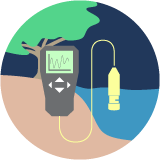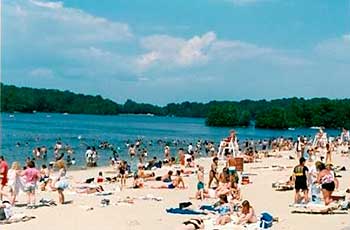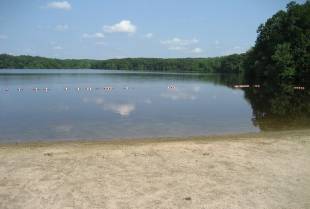 Value to Management
Value to Management
- Identifies public health risks: Contaminated beaches pose public health risks and can negatively impact recreation opportunities if not properly monitored and managed.
- Informs beach closure protocols: Managers ensure that licensed beaches are safe for swimming from a health perspective, develop preemptive beach closure protocols to protect public health, and evaluate the efficacy of current monitoring and notification methods.
- Tracks pollution sources: Regulators work to fully eliminate the public health risk of contaminated beaches by identifying and remedying as possible any sources of pollution. Beach monitoring data are critical to finding and eliminating sources of contamination at freshwater beaches.

Though perhaps not Rhode Island’s most touted natural feature given our Ocean State moniker, hundreds of freshwater lakes and ponds cover 20,749 acres. Little Rhody has no shortage of freshwater shores to explore and enjoy. These freshwater beaches are a critical introduction to the environment for young people; more than half of all licensed freshwater facilities are children’s summer camps and recreational facilities.
Unlike with saltwater beaches, the RI Department of Health does not conduct a comprehensive freshwater beach monitoring program; however, owners of licensed bathing beaches are required to test for bacterial contamination to make sure they are safe for wading, swimming, and recreation. Bacteria presents a health risk to swimmers as it can result in gastroenteritis, which is characterized by inflammation of the stomach and the intestines and most often identified by symptoms such as vomiting, headaches, and fever. These bacteria can also cause ear, eye, nose, throat, and skin infections.
Contamination at freshwater beaches can come from many sources. In some areas, stormwater runoff and combined sewer overflows are an issue, just as with saltwater beaches. In other areas, bacteria from human waste in septic systems can travel through groundwater or stormwater and contaminate beaches. Fecal matter from domestic pets as well as waterfowl and other wildlife can also lead to bacterial contamination.

Protecting beachgoers from health risks due to pathogen contamination requires several actions: 1) monitor the freshwater beaches for potential contamination; 2) close the beach and notify beachgoers if there is an unsafe level of pathogens present; and 3) reduce numbers of pathogens entering the water body from land-based sources to prevent future beach closures and health risks.
